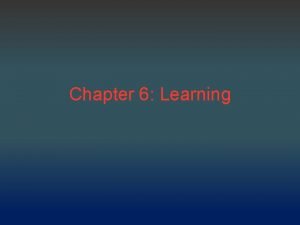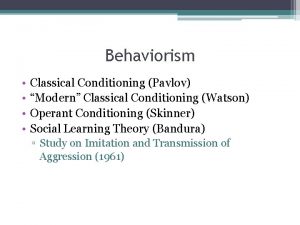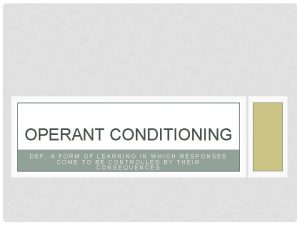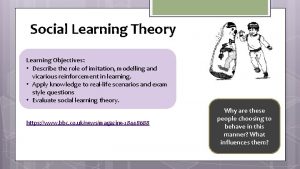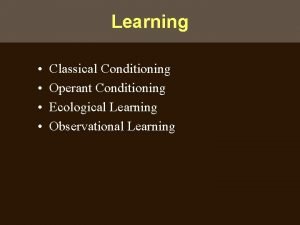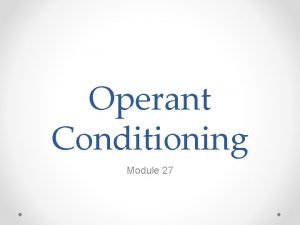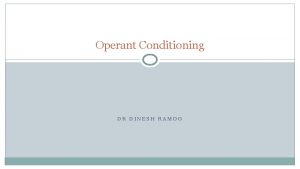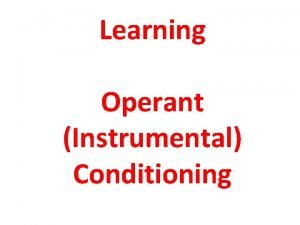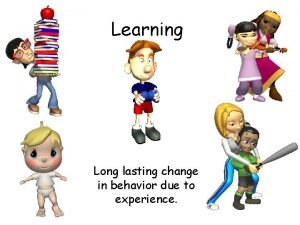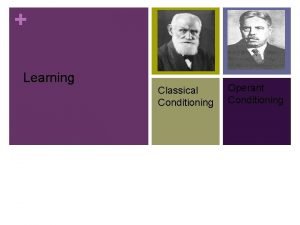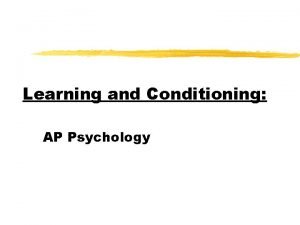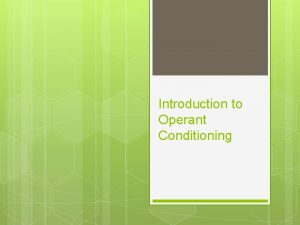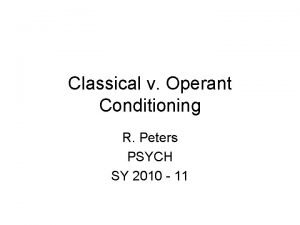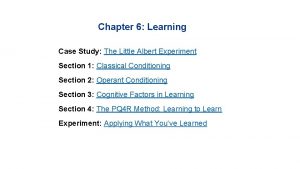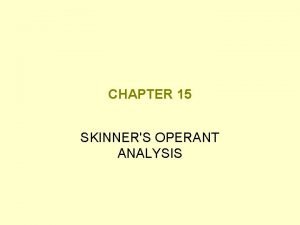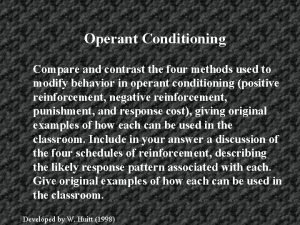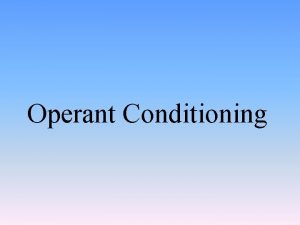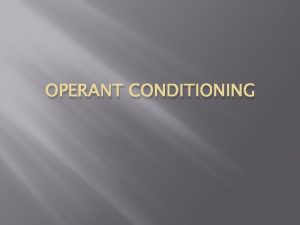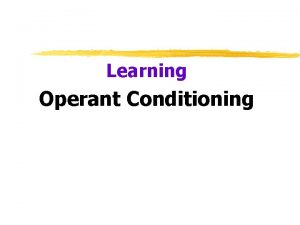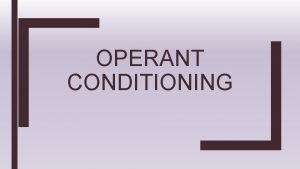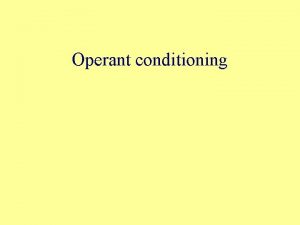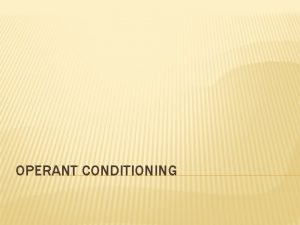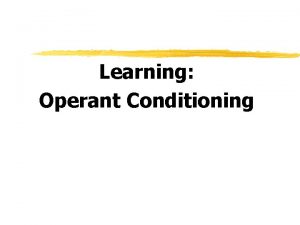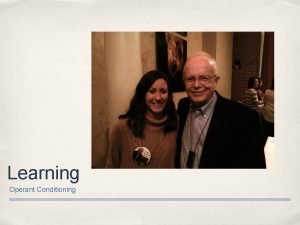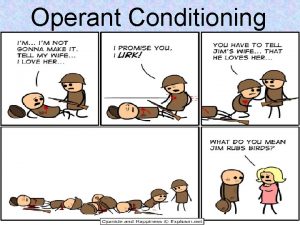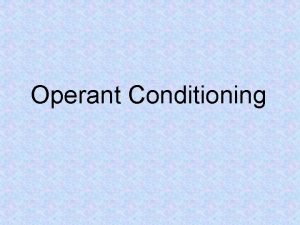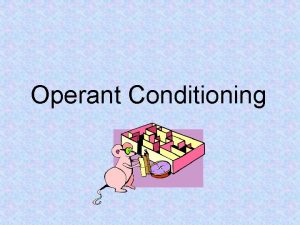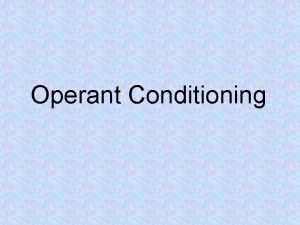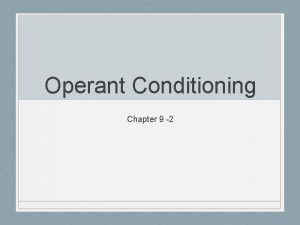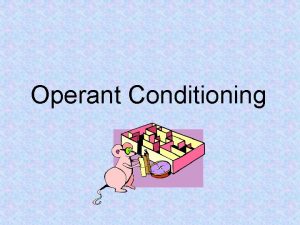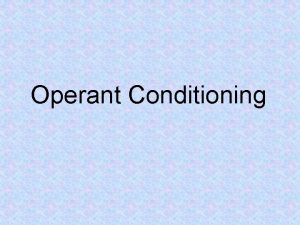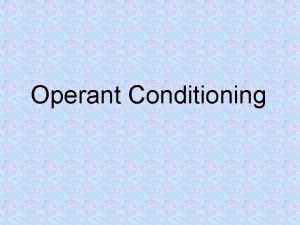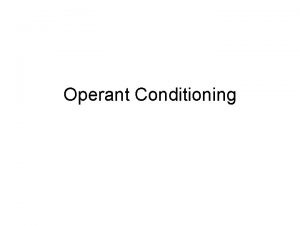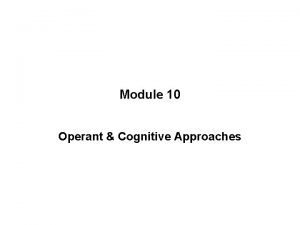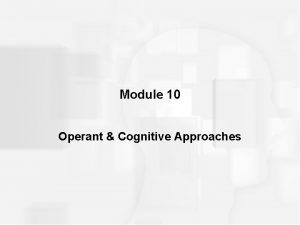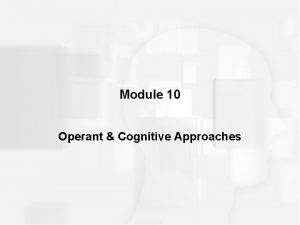OPERANT CONDITIONING DEF A FORM OF LEARNING IN






























- Slides: 30

OPERANT CONDITIONING DEF: A FORM OF LEARNING IN WHICH RESPONSES COME TO BE CONTROLLED BY THEIR CONSEQUENCES

THORNDIKE’S LAW OF EFFECT • Edward L. Thorndike • Studied instrumental learning • This is the foundation of operant conditioning • Cat studies

LAW OF EFFECT • DEF: if a response in the presence of a stimulus leads to a satisfying effects, the association between the stimulus and the response is strengthened • The cornerstone of B. F. Skinner’s theory

SKINNER’S DEMONSTRATION • Skinner showed that organisms tend to repeat those responses that are followed by favorable consequences • Reinforcement: occurs when an event following a response increases an organism’s tendency to make that response

TERMINOLOGY • Operant chamber: “Skinner Box”, a small enclosure in which an animal can make a specific response that is recorded while the consequences of the response are systematically controlled • Used to control Reinforcement contingencies: rules that determine whether response lead to the presentation of reinforcers

OPERANT CONDITIONING • Key dependent variable is subject’s response rate over time • Cumulative recorder: creates a graphic record of responding and reinforcement in a Skinner box as a function of time

BASIC PROCESSES OF OPERANT CONDITIONING • Shaping: the reinforcement of closer and closer approximations of a desired response • Important in acquisition • Necessary when an organism does not emit the desired response

BASIC PROCESSES OF OPERANT CONDITIONING • Extinction: weakening and disappearance of a response tendency b/c the response is no longer followed by a reinforcer • Resistance to extinction: when an organism continues to make a response after delivery of the reinforcer for it has been terminated

DISCRIMINATIVE STIMULI • DEF: cues that influence operant behavior by indicating the probable consequences of a response • Regulate operant behavior

STIMULUS GENERALIZATION/DISCRIMINATION • Generalization: Responding to a new stimulus as if it were the original • Stimulus discrimination: decrease in response to a new stimulus that resembles the original

REINFORCEMENT • Strengthening of a response tendency • Defined after the fact, in terms of effect on behavior • Reinforcement is subjective

DELAYED REINFORCEMENT • Favorable outcomes are more likely to strengthen a response if the outcome follows immediately

CONDITIONED REINFORCEMENT • Primary reinforcers: events that are inherently reinforcing b/c they satisfy biological needs • Secondary (conditioned) reinforcers: events that acquire reinforcing qualities by being associated w/primary reinforcers

INTERMITTENT REINFORCEMENT: EFFECTS OF BASIC SCHEDULES • Schedule of reinforcement: determines which occurrences of a specific response result in the presentation of a reinforcer

INTERMITTENT REINFORCEMENT • Continuous reinforcement: occurs when every instance of a designated response is reinforced • Intermittent, partial, reinforcement: occurs when a designated response is reinforced only some of the time • Intermittent makes a response more resistant to extinction • There are 4 types of intermittent reinforcement…

FIXED-RATIO (FR) SCHEDULE • Ratio schedules require the organism to make a response a certain amount of times to gain a reinforcer • FR Schedule: the reinforcer is given after a fixed number of nonreinforced responses

VARIABLE-RATIO (VR) SCHEDULE • The reinforcer is given after a variable number of nonreinforced responses

FIXED-INTERVAL (FI) SCHEDULE • Interval schedules require a time period to pass btwn presentation of reinforcers • FI Schedule: the reinforcer is given for the 1 st response that occurs after a fixed time interval has elapsed

VARIABLE-INTERVAL (VI) SCHEDULE • The reinforcer is given for the 1 st response after a variable time interval has elapsed • Interval length depends on a predetermined avg.

RATIO VS. INTERVAL • Ratio schedules produce more rapid responding • Variable schedules tend to generate steadier response rates and greater resistance to extinction

CONCURRENT SCHEDULES OF REINFORCEMENT • Concurrent schedules of reinforcement: consist of 2 or more reinforcement schedules that operate simultaneously and independently, each for a different response

MATCHING LAW • States that under concurrent schedules of reinforcement, organisms’ relative rate of responding to each alternative tends to match each alternative’s relative rate of reinforcement • Quality of reinforcement earned also effects response rate • Assumes organisms are working to maximize their overall reinforcement

MATCHING AND FORAGING • Optimal foraging theory: food seeking behaviors of many animals maximize the nutrition gained in relation to the energy expended to locate, secure, and consume various foods

POSITIVE REINFORCEMENT • Occurs when a response is strengthened b/c it is followed by the presentation of a rewarding stimulus

NEGATIVE REINFORCEMENT • Occurs when a response is strengthened b/c it is followed by the removal of an aversive stimulus • Don’t be confused by word negative • Many everyday behaviors effected by negative reinforcement

ESCAPE LEARNING • Def: an organism acquires a response that decreases or ends some aversive stimulation • Shuttle box

AVOIDANCE LEARNING • DEF: an organism acquires a response that prevents some aversive stimulation from occurring • Avoidance learning responses are very resistant to extinction

TWO-PROCESS THEORY OF AVOIDANCE • Avoidance begins b/c classical conditioning creates a conditioned fear • Avoidance is maintained by operant conditioning • Avoidance response is strengthened through negative reinforcement

PUNISHMENT: CONSEQUENCES THAT WEAKEN RESPONSES • Punishment occurs when an event following a response weakens the tendency to make that response • NOT NEGATIVE REINFORCEMENT!!!

PUNISHMENT • Can have side effects: • General suppression of behavioral activity • Trigger strong emotional responses • Physical punishment often leads to aggressive behavior • More effective to reinforce desirable behavior than punish undesirable behavior
 Skinner's schedules of reinforcement
Skinner's schedules of reinforcement The little albert experiment
The little albert experiment Operant vs classical conditioning
Operant vs classical conditioning Instrumental learning vs classical conditioning
Instrumental learning vs classical conditioning Operant conditioning types
Operant conditioning types Examples of negative reinforcement in the classroom
Examples of negative reinforcement in the classroom Secondary reinforcer
Secondary reinforcer Classical and operant conditioning
Classical and operant conditioning Classical conditioning vs operant conditioning
Classical conditioning vs operant conditioning Operant conditioning classical conditioning
Operant conditioning classical conditioning Operant conditioning def
Operant conditioning def Vicarious reinforcement
Vicarious reinforcement Partial reinforcement
Partial reinforcement Classical conditioning examples
Classical conditioning examples Home youtube
Home youtube Operant conditioning edward thorndike
Operant conditioning edward thorndike Dinesh ramoo
Dinesh ramoo Insight learning theory
Insight learning theory Examples of fixed ratio schedule
Examples of fixed ratio schedule Operant conditioning
Operant conditioning An event that leads to lasting change
An event that leads to lasting change Fixed ratio reinforcement schedule
Fixed ratio reinforcement schedule Ap psychology learning
Ap psychology learning Example of fixed ratio schedule
Example of fixed ratio schedule Operant conditioning examples
Operant conditioning examples Operant conditioning definition
Operant conditioning definition Shaping in operant conditioning
Shaping in operant conditioning Operant conditioning and personality
Operant conditioning and personality Classical conditioning cs us ur cr
Classical conditioning cs us ur cr Compare and contrast operant and classical conditioning
Compare and contrast operant and classical conditioning Principles of operant conditioning
Principles of operant conditioning







